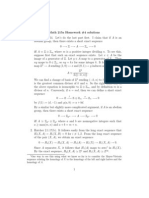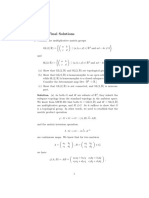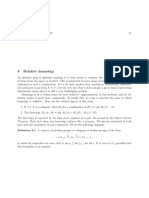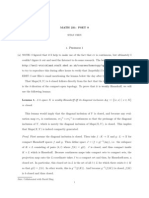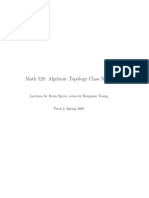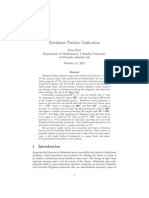Midterm Solutions
Uploaded by
aqp1118179Midterm Solutions
Uploaded by
aqp1118179Math 215B Take-home Midterm Solutions
February 20, 2013
1. (10 points total) Wrong-way maps. We have seen that singular homology is a
functorial assignment, that is, given a map f : X Y of topological spaces, there
is an induced map f
: H
i
(X) H
i
(Y ) on homology groups. In some cases, if the
map f : X Y is particularly nice, there also exists a map f
!
: H
i
(Y ) H
i
(X),
called a wrong-way or transfer map.
a. (5 points) Let p :
X X be a k-sheeted covering map, for some nite k.
Construct a (non-trivial!) map of chain complexes
C
i
(X) C
i
(
X) (1)
and show that it is a chain map, giving rise to an induced map on homology
p
!
: H
i
(X) H
i
(
X). (2)
b. (5 points). Show that the composition
p
p
!
: H
i
(X) H
i
(X) (3)
is multiplication by k.
Solution: 1a. Dene the chain map : C
n
(X) C
n
(
X) by taking each n-simplex
:
n
X
to the sum of its k lifts to
X. There are always exactly k lifts, since 1.33 and 1.34 in
Hatcher tell us that each preimage of (x
0
) corresponds to a unique lift, and there
are k such preimages. Taking the ith face of each of these k lifts, we get k distinct
lifts of
i
, which must be the k unique lifts of this (k 1)-simplex. Therefore
taking the sum of lifts commutes with
i
, so it commutes with =
i
(1)
i
i
as
well. Therefore a chain map, so it passes to a transfer map on homology
H
n
(X) H
n
(
X)
1b. It suces to show that p
#
is multiplication by k, before passing to homology
classes. Under this chain map, the simplex goes to the sum of its k lifts, each
of which is then mapped back to , so we get a sum of k copies of . So p
#
is
multiplication by k and we are done.
2. (14 points total) Applications to group theory.
a. (7 points) Let X be a wedge sum of n circles, with its natural graph structure,
and let
X X be a covering space with Y
X a nite connected graph.
Show there is a nite graph Z Y having the same vertices as Y , such that
the projection Y X extends to a covering space Z X.
b. (7 points) Using the above fact if necessary, prove the following result in group
theory: Let F be a nitely generated free group, H F a nitely generated
subgroup, and x F H. Then there is a subgroup K of nite index such that
K H and x / K.
Solution: 2a. Label the n loops of X by a
1
, . . . , a
n
. We will adopt the convention
that each lift of a
i
in
X or Z will also be labelled a
i
.
Suppose that Y has m vertices, and x a value of i between 1 and n. There are
k edges labelled a
i
in Y , with 0 k m. Since Y is contained in a cover of X,
each vertex of Y has at most one edge labelled a
i
coming in or going out. There
are m vertices and k edges labelled a
i
, so exactly mk of the vertices have no a
i
coming in, and exactly m k of the vertices have no a
i
going out. Therefore we
may pick a bijection
vertices with no a
i
going out
=
vertices with no a
i
coming in
and this bijection tells us how to attach mk more edges to Y so that each each
vertex has exactly one edge labelled a
i
pointing in and one edge labelled a
i
pointing
out. Doing this separately for each value of i, we arrive at a graph Z containing Y
whose edges are labelled in a way that describes a covering map Z X extending
Y X. Note that Z will not in general be contained in
X.
2b. We are given a nitely generated free group F, a nitely generated subgroup
H, and an element x F H. Let X be a wedge of one circle for each generator
of F, so
1
(X)
= F. Let (
X, x
0
) (X, x
0
) be a cover associated to H F. For
each element of some nite set of generators for H, pick a nite edgepath
i
that
begins and ends at x
0
. In addition, pick a nite edgepath in
X that starts at
x
0
and lifts the loop in X corresponding to x. Since x is not in the subgroup H,
will not end at x
0
. Now let Y be the union of and all the
i
, and extend
Y to a covering space Z using the above problem. Let K F be the subgroup
corresponding to the image of
1
(Z, x
0
) in
1
(X). Then K obviously contains H,
but it does not contain x because the path representing x in X lifts to in Z,
which is not a closed loop. Finally, K has nite index because Z has nitely many
vertices, which are the preimages of the basepoint of X.
3. (12 points) Spaces not distinguished by homology. Show that S
1
S
1
and S
1
S
1
S
2
have isomorphic homology groups in all dimensions, but their universal covering
spaces do not.
Solution: Using previous computations, the homology groups of S
1
S
1
are
Z, Z
2
, Z. Using the formula for the reduced homology of a wedge, the homology
groups of S
1
S
1
S
2
are also Z, Z
2
, Z. The universal cover of S
1
S
1
is R
2
,
which is contractible, so it has the homology of a point. The universal cover of
S
1
S
1
S
2
is obtained from the universal cover of S
1
S
1
by attaching a copy of
S
2
to every vertex. This is a 2-dimensional CW complex in which the 1-skeleton
is a tree. Contracting this tree to a point, we get a countable wedge of 2-spheres,
so its homology is a countable direct sum
i=1
Z in degree 2, and 0 in all other
positive degrees.
4. (10 points) Homological algebra. Let (C
n
, ) be a collection of chain complexes
indexed by n Z, i.e., for each n Z, there is a chain complex
C
n
k
C
n
k1
C
n
k2
. (4)
Let f
n
: C
n
C
n+1
be a chain map, one for each n. Suppose that the composite
f
n+1
f
n
: C
n
C
n+2
is chain-homotopic to zero for all n, by a chain homotopy
K
n
: C
n
C
n+2
+1
; that is,
f
n+1
f
n
= K
n
+ K
n
(5)
First part: Show that the map
n
:= f
n+2
K
n
K
n+1
f
n
(6)
is an anti-chain map from C
n
C
n+3
, meaning that
n
=
n
, and deduce
that
n
gives rise to a map on homology,
: H
i
(C
n
, ) H
i+1
(C
n+3
, ) (7)
for all n and i. Second part: Finally, suppose that (7) is an isomorphism for all
n and i. Deduce that the sequence
H
i
(C
n
, )
f
n
H
i
(C
n+1
, )
f
n+1
H
i
(C
n+2
, ) (8)
is exact.
Solution of rst part: First, lets check that
n
is an anti-chain map. We
compute, using the chain homotopy equation f
n+1
f
n
= K
n
+K
n
and the fact
that f
n
is a chain map, so f
n
= f
n
:
n
= f
n+2
K
n
K
n+1
f
n
(9)
= f
n+2
K
n
(K
n+1
+ f
n+2
f
n+1
) f
n
(10)
= f
n+2
(K
n
+ f
n+1
f
n
) K
n+1
f
n
+ f
n+2
f
n+1
f
n
(11)
= f
n+2
K
n
+ K
n+1
f
n
(12)
= (f
n+2
K
n
K
n+1
f
n
) (13)
=
n
. (14)
Let us show an anti-chain map gives rise to a well-dened map on homology
: H
i
(C
n
) H
i+1
(C
n+3
)
[] []
(15)
First, we must check it sends cycles to cycles. If is a cycle, then = = 0
as desired. To check well-denedness, suppose + is another representative of
[]. Then, ( + ) = is homologous to .
Solution of second part: Before proceeding, let us verify a key identity involving
.
Claim: On homology, we have
f
n1
= f
n+2
n1
. (16)
Proof of Claim. We compute, for a cycle C
n1
(so = 0):
n
f
n1
= (f
n+2
K
n
K
n+1
f
n
)f
n1
(17)
= f
n+2
K
n
f
n1
K
n+1
f
n
f
n1
(18)
= f
n+2
K
n
f
n1
K
n+1
(K
n1
+ K
n1
) (19)
= f
n+2
K
n
f
n1
K
n+1
K
n1
(20)
= f
n+2
K
n
f
n1
(f
n+2
f
n+1
K
n+1
)K
n1
(21)
= f
n+2
(K
n
f
n1
f
n+1
K
n1
) + K
n+1
K
n1
(22)
= f
n+2
n1
+ (a boundary), (23)
verifying the claim.
Now, suppose that
n
is an isomorphism. We need to verify the sequence (8) is
exact, i.e. ker f
n+1
= im f
n
. There are two assertions to check:
im f
n
ker f
n+1
: this follows immediately from the chain homotopy (5).
Indeed, for a cycle imf
n
, so is homologous to f
n
, for some cycle ,
we have that
f
n+1
= f
n+1
f
n
+ f
n+1
(a boundary)
= (K
n
+ K
n
) + f
n+1
(a boundary)
= (a boundary),
(24)
as = 0, verifying that on homology f
n+1
[] = 0, so ker f
n+1
.
ker f
n+1
im f
n
: Suppose we have a cycle C
n+1
with [] ker f
n+1
, so
f
n+1
= . By the isomorphism (7), is homologous to
n2
, for some
cycle C
n2
.
Now, using the key identity, note that
f
n+1
f
n+1
n
=
n1
f
n2
+ ( a boundary). (25)
So, if f
n+1
is a boundary, then
n1
f
n2
is a boundary, which by the
isomorphism (7), implies that f
n2
is a boundary, i.e.
f
n2
= . (26)
Then, note that
n2
(27)
= (f
n
K
n2
K
n1
f
n2
) (28)
= f
n
K
n2
K
n1
(29)
= f
n
K
n2
(f
n
f
n1
K
n1
) = f
n
(K
n2
f
n1
) (K
n1
).
(30)
If we can show that := (K
n2
f
n1
) is closed, then the above calculation
will imply that f
n
[] = [] as desired. We check:
= (K
n2
f
n1
) (31)
= (f
n1
f
n2
f
n1
) (32)
= (f
n1
f
n2
f
n1
f
n2
) (33)
= 0. (34)
5. (14 points total) SO(3) and the quaternions. The topological group SO(3) is
dened as the space of real 3 x 3 matrices A with that are orthogonal (meaning
A
T
= A
1
) and have determinant 1. The topology on SO(3) is the subspace
topology, coming from the inclusion of SO(3) R
9
, the space of all 3 x 3 matrices.
Let H denote the group of quaternions (recall that these are numbers of the form
a +b i +c j +d k, for a, b, c, d R, with non-commutative multiplication rules
determined by i
2
= j
2
= k
2
= 1, ij = ji = k).
a. (6 points) A quaternion is called pure if it has 0 real part, i.e., it is of the form
b i +c j +d k. Thinking of R
3
as the subspace of pure quaternions in H, any
quaternion q H induces a map
A
q
: R
3
R
3
x qxq
1
.
(35)
Show that when restricted to the unit quaternions (those with norm 1 using the
usual Euclidean norm in R
4
), such a correspondence gives a (continuous) map
: S
3
SO(3). (36)
b. (8 points) Prove that the map is a covering map, and use it to calculate
1
(SO(3)).
Solutions: 5a. We use the following facts: the quaternions have a multiplicative
norm, dened for
q = a + bi + cj + dk
as
|q| =
a
2
+ b
2
+ c
2
+ d
2
Also, the inverse of q is given by
a bi cj dk
|q|
2
Since inversion of unit quaternions and multiplication of quaternions are both given
by polynomials in each coordinate, they dene continuous maps, so the given map
A
: S
3
M
33
(R)
is continuous. Since multiplication of quaternions preserves norms, the assignment
x qxq
1
preserves the norm of x as a vector in R
3
, so it denes an element of O(3). Therefore
A
q
gives a continuous map
S
3
O(3)
Since S
3
is connected, this map must land in the path component of the identity,
which is SO(3).
5b. The map dened above
: S
3
SO(3)
is clearly a homomorphism of groups. It is surjective because we can check that
quaternions of the form a + bi hit the rotations about the i-axis, and similarly
a + cj hits the rotations about the j-axis, and these are enough to generate the
rotations of R
3
. The map has kernel 1 since a quaternion that xes the i axis
must be of the form a +bi, and if it xes the j axis it must be of the form a +cj,
so if it xes both then it must be real, which leaves only +1 and 1.
Now we will show is a covering map. It suces to do this at the identity of
SO(3), since we can use left-multiplication to translate the result to all other
points. We pick a small neighborhood U of the identity 1 SO(3) such that
its preimage
1
(U) lies in two small balls about +1 and 1 in S
3
. Focus on
the component V
+1
1
(U) about +1; we need to show that : V
+1
U is
a homeomorphism. We already know from the above that it is surjective. For
injectivity, if two quaternions q
1
, q
2
V
+1
gave the same rotation in U, then
q
1
q
1
2
= 1, but when U is small enough the only possibility is +1, so q
1
= q
2
. Now
: V
+1
U is a continuous bijection, but by restricting to a slightly smaller closed
ball C U and its preimage, we get a continuous bijection between a compact
space and a Hausdor one, which is therefore a homeomorphism. Restricting this
to an even slightly smaller open ball U
C, we conclude that U
is an evenly
covered open set.
Now we know that is a 2-sheeted cover. Since S
3
is simply connected, it is the
universal cover of SO(3) and so
1
(SO(3))
= Z/2.
6. (18 points total) Computation via decompositions. Let X be the quotient space of
S
2
obtained by identifying the north and south poles to a single point.
a. (6 points) Put a cell complex structure on X and use this to compute
1
(X).
b. (6 points) Put a -complex structure on X and use this to compute H
(X),
its simplicial homology for this structure.
c. (6 points) Compute the singular homology of X directly, using the Mayer-
Vietoris sequence or excision.
Solutions: See next page.
7. (12 points total) A covering space corresponding to a subgroup. Let X be a wedge of
three circles with basepoint p the common point at which the circles are wedged.
We showed in class that the fundamental group of
1
(X, p) is a, b, c, the free
group on three generators.
a. (7 points) Let G
1
(X, p) be the subgroup
G := a
4
, ac, c
2
, ab, b
2
, a
2
ba
3
, a
2
b
1
a
3
, a
2
ca
3
, a
2
c
1
a
3
. (37)
Find a covering space with basepoint
: (
X, p) (X, p) (38)
corresponding to the group G.
b. (5 points) Now, using the topology of this covering space, prove that G is not
a normal subgroup of a, b, c.
Solutions: See next page.
You might also like
- P. M. H. Wilson-Curved Spaces - From Classical Geometry To Elementary Differential Geometry-CUP (2008) PDF100% (3)P. M. H. Wilson-Curved Spaces - From Classical Geometry To Elementary Differential Geometry-CUP (2008) PDF198 pages
- Clifford Algebras An Introduction Garling CUP 2011No ratings yetClifford Algebras An Introduction Garling CUP 2011210 pages
- Solutions - A Concise Course in Algebraic TopologyNo ratings yetSolutions - A Concise Course in Algebraic Topology12 pages
- Homological Algebra - Problem Set 1 - SolutionsNo ratings yetHomological Algebra - Problem Set 1 - Solutions9 pages
- Notes For The Reu: July 28 Scribe: Wei Ren: n+1 D N D N 1No ratings yetNotes For The Reu: July 28 Scribe: Wei Ren: n+1 D N D N 13 pages
- Selected Geometry & Topology Qualifying Exam Solutions: 1 NavigationNo ratings yetSelected Geometry & Topology Qualifying Exam Solutions: 1 Navigation71 pages
- Algebraic Topology: Or257/teaching/notes/at PDFNo ratings yetAlgebraic Topology: Or257/teaching/notes/at PDF80 pages
- The Non-Nil-Invariance of TP: Ryo HoriuchiNo ratings yetThe Non-Nil-Invariance of TP: Ryo Horiuchi7 pages
- Verschiebung Maps Among K-Groups of Truncated Polynomial AlgebrasNo ratings yetVerschiebung Maps Among K-Groups of Truncated Polynomial Algebras16 pages
- Problem Set 3: Hint: Decompose K Into A Pair of Arcs, Then Take Their Complements in SNo ratings yetProblem Set 3: Hint: Decompose K Into A Pair of Arcs, Then Take Their Complements in S2 pages
- Topology - Tutorial Sheet 4 (With Solutions)No ratings yetTopology - Tutorial Sheet 4 (With Solutions)9 pages
- Elementary Homology Theory With ComputationsNo ratings yetElementary Homology Theory With Computations11 pages
- Lecture Notes On Homology Theory: Dr. Thomas Baird (Illustrations by Nasser Heydari) Winter 2014No ratings yetLecture Notes On Homology Theory: Dr. Thomas Baird (Illustrations by Nasser Heydari) Winter 201474 pages
- The Arithmetic Square (Lecture 32) : July 11, 2008No ratings yetThe Arithmetic Square (Lecture 32) : July 11, 20084 pages
- Introduction To Topology Exercises III November 2012No ratings yetIntroduction To Topology Exercises III November 20123 pages
- Math 213a: Homework 2: Vinh-Kha Le September 2018No ratings yetMath 213a: Homework 2: Vinh-Kha Le September 201810 pages
- Lecture 6: Introduction To Simplicial HomologyNo ratings yetLecture 6: Introduction To Simplicial Homology6 pages
- Math 528 Algebraic Topology Class NotesNo ratings yetMath 528 Algebraic Topology Class Notes119 pages
- From 3D To 2D: Orthographic and Perspective Projection-Part 1No ratings yetFrom 3D To 2D: Orthographic and Perspective Projection-Part 134 pages
- Introduction To Group Theory: With Applications To Quantum Mechanics and Solid State Physics100% (2)Introduction To Group Theory: With Applications To Quantum Mechanics and Solid State Physics114 pages
- Kirillovs - COMPACT GROUPS AND THEIR REPRESENTATIONSNo ratings yetKirillovs - COMPACT GROUPS AND THEIR REPRESENTATIONS12 pages
- Groups and Computation III Proceedings of The International Conference at The Ohio State University June 15 19 1999 William M. Kantor (Editor)100% (11)Groups and Computation III Proceedings of The International Conference at The Ohio State University June 15 19 1999 William M. Kantor (Editor)84 pages
- Gauge Theories Lecture Notes by Matthew de Angelis100% (1)Gauge Theories Lecture Notes by Matthew de Angelis84 pages
- 1.1 Manifolds: Definitions and First ExamplesNo ratings yet1.1 Manifolds: Definitions and First Examples19 pages
- How Big Is That Cookie? The Integral Geometric Approach To Geometrical QuantitiesNo ratings yetHow Big Is That Cookie? The Integral Geometric Approach To Geometrical Quantities45 pages
- Lecture Notes On Orthogonal Polynomials of Several Variables by DR Yaun Xu PDFNo ratings yetLecture Notes On Orthogonal Polynomials of Several Variables by DR Yaun Xu PDF54 pages
- PDF Notes on differential geometry and Lie groups Gallier J. download100% (1)PDF Notes on differential geometry and Lie groups Gallier J. download81 pages
- Angular Momentum and Rotations: Classical Mechanics HomeworkNo ratings yetAngular Momentum and Rotations: Classical Mechanics Homework3 pages
- University of Cambridge Faculty of Mathematics: Schedules of Lecture CoursesNo ratings yetUniversity of Cambridge Faculty of Mathematics: Schedules of Lecture Courses43 pages
- Learning Algorithms Utilizing Quasi-Geodesic Flows On The Stiefel ManifoldNo ratings yetLearning Algorithms Utilizing Quasi-Geodesic Flows On The Stiefel Manifold30 pages
- Department: Mathematics S. Y. B.Sc. SyllabusNo ratings yetDepartment: Mathematics S. Y. B.Sc. Syllabus25 pages
- Buy ebook Algebra 2 Linear Algebra Galois Theory Representation theory Group extensions and Schur Multiplier 1st Edition Ramji Lal cheap price100% (4)Buy ebook Algebra 2 Linear Algebra Galois Theory Representation theory Group extensions and Schur Multiplier 1st Edition Ramji Lal cheap price55 pages
- The Higgs Boson For Mathematicians. Lecture Notes On Gauge Theory and Symmetry BreakingNo ratings yetThe Higgs Boson For Mathematicians. Lecture Notes On Gauge Theory and Symmetry Breaking28 pages
- Part IB - Geometry: Based On Lectures by A. G. KovalevNo ratings yetPart IB - Geometry: Based On Lectures by A. G. Kovalev63 pages
- P. M. H. Wilson-Curved Spaces - From Classical Geometry To Elementary Differential Geometry-CUP (2008) PDFP. M. H. Wilson-Curved Spaces - From Classical Geometry To Elementary Differential Geometry-CUP (2008) PDF
- Clifford Algebras An Introduction Garling CUP 2011Clifford Algebras An Introduction Garling CUP 2011
- Solutions - A Concise Course in Algebraic TopologySolutions - A Concise Course in Algebraic Topology
- Notes For The Reu: July 28 Scribe: Wei Ren: n+1 D N D N 1Notes For The Reu: July 28 Scribe: Wei Ren: n+1 D N D N 1
- Selected Geometry & Topology Qualifying Exam Solutions: 1 NavigationSelected Geometry & Topology Qualifying Exam Solutions: 1 Navigation
- Verschiebung Maps Among K-Groups of Truncated Polynomial AlgebrasVerschiebung Maps Among K-Groups of Truncated Polynomial Algebras
- Problem Set 3: Hint: Decompose K Into A Pair of Arcs, Then Take Their Complements in SProblem Set 3: Hint: Decompose K Into A Pair of Arcs, Then Take Their Complements in S
- Lecture Notes On Homology Theory: Dr. Thomas Baird (Illustrations by Nasser Heydari) Winter 2014Lecture Notes On Homology Theory: Dr. Thomas Baird (Illustrations by Nasser Heydari) Winter 2014
- The Arithmetic Square (Lecture 32) : July 11, 2008The Arithmetic Square (Lecture 32) : July 11, 2008
- Introduction To Topology Exercises III November 2012Introduction To Topology Exercises III November 2012
- Transformation of Axes (Geometry) Mathematics Question BankFrom EverandTransformation of Axes (Geometry) Mathematics Question Bank
- From 3D To 2D: Orthographic and Perspective Projection-Part 1From 3D To 2D: Orthographic and Perspective Projection-Part 1
- Introduction To Group Theory: With Applications To Quantum Mechanics and Solid State PhysicsIntroduction To Group Theory: With Applications To Quantum Mechanics and Solid State Physics
- Kirillovs - COMPACT GROUPS AND THEIR REPRESENTATIONSKirillovs - COMPACT GROUPS AND THEIR REPRESENTATIONS
- Groups and Computation III Proceedings of The International Conference at The Ohio State University June 15 19 1999 William M. Kantor (Editor)Groups and Computation III Proceedings of The International Conference at The Ohio State University June 15 19 1999 William M. Kantor (Editor)
- Gauge Theories Lecture Notes by Matthew de AngelisGauge Theories Lecture Notes by Matthew de Angelis
- How Big Is That Cookie? The Integral Geometric Approach To Geometrical QuantitiesHow Big Is That Cookie? The Integral Geometric Approach To Geometrical Quantities
- Lecture Notes On Orthogonal Polynomials of Several Variables by DR Yaun Xu PDFLecture Notes On Orthogonal Polynomials of Several Variables by DR Yaun Xu PDF
- PDF Notes on differential geometry and Lie groups Gallier J. downloadPDF Notes on differential geometry and Lie groups Gallier J. download
- Angular Momentum and Rotations: Classical Mechanics HomeworkAngular Momentum and Rotations: Classical Mechanics Homework
- University of Cambridge Faculty of Mathematics: Schedules of Lecture CoursesUniversity of Cambridge Faculty of Mathematics: Schedules of Lecture Courses
- Learning Algorithms Utilizing Quasi-Geodesic Flows On The Stiefel ManifoldLearning Algorithms Utilizing Quasi-Geodesic Flows On The Stiefel Manifold
- Buy ebook Algebra 2 Linear Algebra Galois Theory Representation theory Group extensions and Schur Multiplier 1st Edition Ramji Lal cheap priceBuy ebook Algebra 2 Linear Algebra Galois Theory Representation theory Group extensions and Schur Multiplier 1st Edition Ramji Lal cheap price
- The Higgs Boson For Mathematicians. Lecture Notes On Gauge Theory and Symmetry BreakingThe Higgs Boson For Mathematicians. Lecture Notes On Gauge Theory and Symmetry Breaking
- Part IB - Geometry: Based On Lectures by A. G. KovalevPart IB - Geometry: Based On Lectures by A. G. Kovalev





